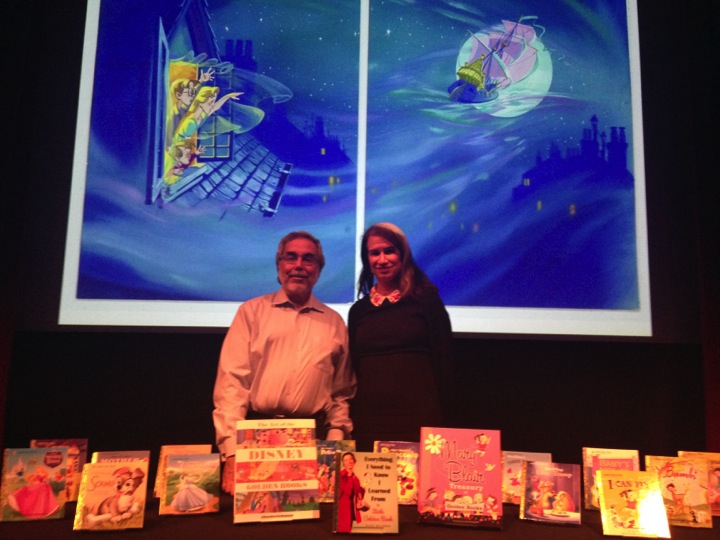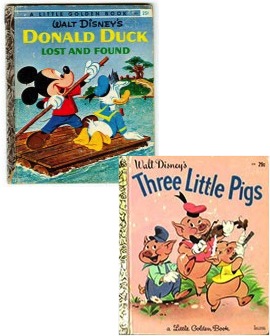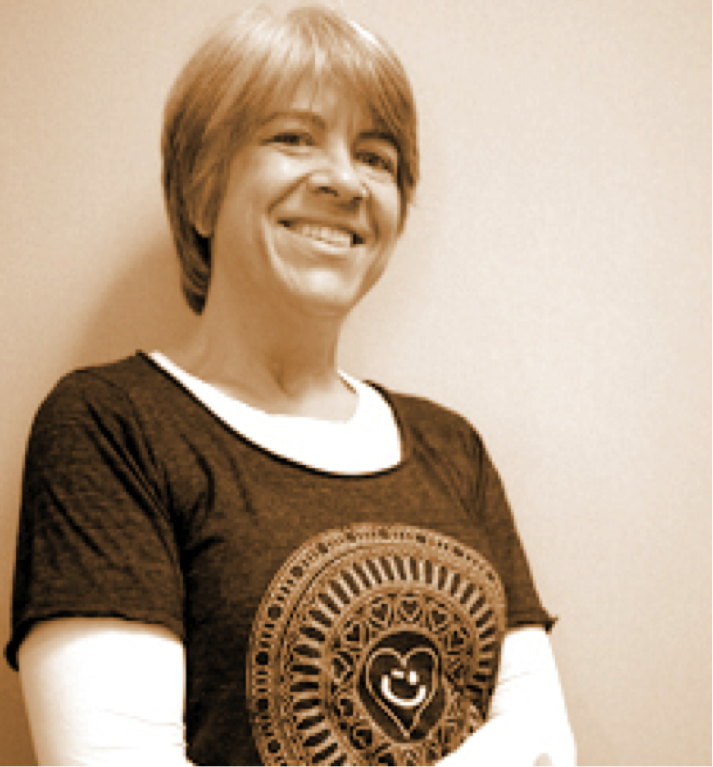On Saturday, June 28th, The Walt Disney Family Museum hosted the last of a series of special programs associated with the special exhibition, MAGIC, COLOR, FLAIR: the world of Mary Blair, which is on view until September 7.
The lecture/discussion, The Golden Disney Legacy, celebrated the rich history and collaboration between The Walt Disney Company and Golden Books, now a division of Random House Publishing.
Many smiles were evident as the audience settled into their seats and enjoyed the table display of Disney Golden Books at the front of the theater. The arrangement before them was a collection of classic, toddler hand-sized books with cardboard covers and familiar gold foil spines. They included both Disney feature film and non-Disney titles such as Bambi, Pinocchio, Dumbo, Sleeping Beauty, Scamp, I Can Fly, Baby’s House, and many more.
The distinguished guest speakers Charles Solomon, an internationally respected critic, animation historian and author of The Art of Disney Golden Books, and Diane Muldrow, author and longtime editorial director at Golden Books/Random House were perfectly positioned to face the audience and to enjoy the incredible artwork they brought to share on the screen.
 Golden Books were first published in the 1940s during a time when children’s books were seen as a luxury, selling from $2 to $3. In a partnership aimed to develop a colorful, durable, affordable children’s book, Simon and Schuster Publishing and Western Printing created the first series of Little Golden Books. Also revolutionary was the broad access of these books, which were sold in drug stores and tobacco shops for $0.25 a copy.
Golden Books were first published in the 1940s during a time when children’s books were seen as a luxury, selling from $2 to $3. In a partnership aimed to develop a colorful, durable, affordable children’s book, Simon and Schuster Publishing and Western Printing created the first series of Little Golden Books. Also revolutionary was the broad access of these books, which were sold in drug stores and tobacco shops for $0.25 a copy.
“The price was the key to success,” stated Muldrow, noting that children could now enjoy their books with a sense of ownership since they could print their names on an inside bookplate graphic. They could also hold on tight to their books, rather than be cautioned by nervous parents, worried about the damage little hands could cause.
Much of the remainder of the discussion focused on the artistry of the incredible illustrations found in the books. Several of the finest artists and animators from The Walt Disney Company were chosen to illustrate for the Little Golden Books. In fact, Solomon and Muldrow were each eager to assert that the books contain works from some of the greatest illustrators of the 20th century including Retta Scott Worcester, Al Dempster, Milt Kahl, Alice and Martin Provensen, J.P. Miller, Aurelius Battaglia, Gustav Tenggren, and, of course, Mary Blair.
The artists were challenged to “capture a moment on the page,”– in order to convey “the character, the action, and even the mood—so a child could easily feel what is happening in the story,” commented Solomon. In response to an image from The Little Red Hen, Muldrow remarked, “…and you can even feel the texture of his shirt, and the picnic basket.”

The artwork of the Little Golden Books continues to inspire artists and illustrators working in the field today. For example, in the Little Golden Book adaptation of Pixar Animation Studios’ popular film Up, the bold colors, shapes, clear edges take us away and into the story—and into a feeling. The art is strongly and intentionally reminiscent of Mary Blair’s work. It is both flat and dimensional. Today’s artists are very aware of their responsibility to continue the unique Golden–Disney Legacy because these kinds of books inspired them, too, when they were children, which led to their decision to pursue an art career. Both Solomon and Muldrow mentioned that they had each heard John Lasseter, chief creative officer for Pixar, say that one of the biggest honors Disney can give an artist today is to invite him to illustrate the related Little Golden Book.
As Ms. Muldrow stated, “Little Golden Books are nearly 75 years old. They've given the world to millions of children, all over the world. I wrote Everything I Need to Know I Learned from a Little Golden Book as a valentine to Golden Books, and to the adults who've never stopped loving them.”
Following the presentation, there was a brief time for questions from the audience, including:
Q: Why do the characters in a Little Golden Book adaptation of a Disney movie look noticeably different than the characters in the films? Why didn’t the publisher just use cels from the production?
A: Walt was insistent that the illustrations in the books be something unique and different from the movie. These illustrations had to be special. Animation is a very different medium print art. The page illustrations and additional graphical accents needed to convey much more, in a shorter “snapshot” amount of time. Animation, on the other hand is meant to convey fluid movement that happens over time.
Q: Where can we go to view more of the Little Golden Books art? Is there a publishing museum with a dedicated exhibit?
A: Diane Muldrow shared that in fact, she had curated an exhibition for the National Center for Children’s Illustrated Literature, which continues to travel around the country.
After the theater program concluded, Solomon and Muldrow stayed to sign copies of their books in the lower lobby, much to the delight of children and adults alike.
 Juli Dempsey is both a member and a volunteer at The Walt Disney Family Museum. When not sharing the inspirational story of Walt Disney, Juli works to inspire workplace passion and purpose as an operations manager at Delivering Happiness. The rest of the time she enjoys spending time with her husband, James, her friends and family, and her cats.
Juli Dempsey is both a member and a volunteer at The Walt Disney Family Museum. When not sharing the inspirational story of Walt Disney, Juli works to inspire workplace passion and purpose as an operations manager at Delivering Happiness. The rest of the time she enjoys spending time with her husband, James, her friends and family, and her cats.
